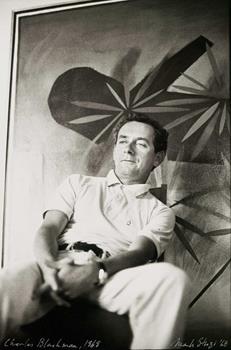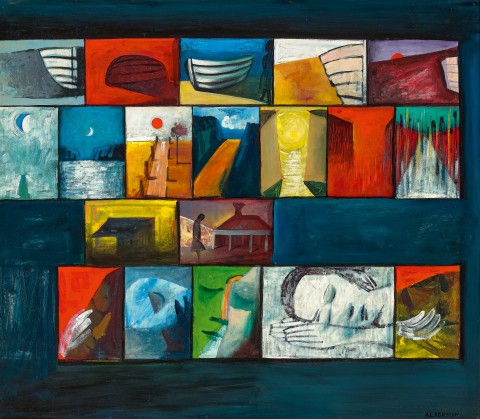SUITE OF PAINTINGS, 1959 - 60
CHARLES BLACKMAN
oil on hardboard
103.5 x 119.0 cm
signed lower right: BLACKMAN
Barbara Blackman AO, Canberra
National Bank of Australia Art Collection, acquired from the above in June 1997 (label attached verso)
Suite I, 1960, oil on hardboard, 122.0 x 183.0 cm, in the collection of the Art Gallery of South Australia, Adelaide
Suite II, 1960, oil and synthetic polymer paint on hardboard, 127.5 x 189.0cm, in the collection of the Art Gallery of New South Wales, Sydney
Suite of Paintings [Suite III], 1960, oil on hardboard, 122.0 x 183.0 cm, in the collection of the Art Gallery of Western Australia, Perth
Suite VI, 1960, oil on hardboard, 120.7 x 182.2 cm, in the collection of the Queensland Art Gallery, Brisbane
We are grateful to Felicity St John Moore for her assistance with this catalogue entry.
BLACKMAN.jpg

Charles Blackman was one of the longest living members of the generation of Melburnian artists known as the Antipodeans, defenders of the merits of figurative art and of a poetic and metaphysical foundation to contemporary painting. In 1960, Blackman brought a decade-long formal inquiry to culmination, developing his interest in sequential and contiguous images into larger compartmentalised systems he called suites. After exploring this new idea through works on paper in the mid-1950s and an experimental work comprising of 18 small pictures mounted on hessian, Collection of Paintings, 1959 (formerly in the collection of Mr and Mrs Brian Johnstone, Brisbane), Blackman painted six large works numbered Suites I – VI, with multifaceted views of shadowy figures with flowers. Blackman could juxtapose in these vignettes static groups and silhouetted glimpses of characters, creating poignant scenes of entrapment, isolation and revelation. Exhibited as a group, these large-scale Suites were met with considerable critical success, winning Blackman the Helena Rubinstein Travelling Art Scholarship in 1960. This prize funded travel to London where Blackman would work alongside fellow Australian émigré artists, profoundly influencing the course of the rest of his artistic career.
Produced alongside these numbered Suites painted specifically for the scholarship, were a number of large paintings of a similar format, some of which were exhibited in Blackman’s sell-out exhibition in Brisbane’s Johnstone Galleries in June 1960 (where three works bore the title ‘Suite of Paintings’). This Suite of Paintings, 1959 – 60 in the collection of the National Bank of Australia was formerly held in the private collection of Barbara Blackman, the artist’s wife, and was never exhibited commercially. Painted in London on Swedish hardboard, Suite of Paintings is composed of four uneven rows of alternating horizontal and portrait format scenes. The upper and lower edges of this suite are bordered in thick bands modulated black-blue paint, which seeps into last two sequential rows. The unevenness of this sequence is unusual in a Suite painting of this period, as are the thin black borders between each window.
Having confined the figurative element of this painting to five individual sleeping figures in the last row, Blackman veered sharply away from the crowded parade of masks and secret gatherings that characterised his earlier Suites. A sense of tension and pregnant possibility is instead created through vignettes of landscapes: empty and beached boats on stark shorelines; reflected moonlight on still water; receding pathways to nowhere and deserted bungalows illuminated by ominous red suns. This Suite of Paintings reunites many of Blackman’s most popular motifs, painted in high key tones, and immediately legible graphic stylisation stripped of superfluous detail and outlining the most key elements with severe black lines. Reprising a motif from his major 1956 painting, The Boat (now in the collection of the National Gallery of Victoria), the empty boats are transfigured into vessels of the imagination, having delivered the viewer to a non-specific oneiric location which can only be glimpsed at through narrow cut-out windows. The figures that inhabit this world seem to be able to float between the frames, appearing intermittently in the first and third rows. Felicity St John Moore suggests that the dreamlike contrasts in Blackman’s works were inspired by the works of French symbolist painter Odilon Redon, ‘a duality of dark and light, fantasy and fat, inside and outside, nightmare and drama, harshness and beauty, mysterious expression and pure plastic substance. This duality is internal as well as thematic… the imagery is enigmatic and multilayered.’1
Reiterating his imaginative propositions in separate small images, Blackman’s suites operate like a rondo in music, with each return to the central statement increasing its emotive effect.2 The anonymity of his silhouetted girls and sleeping faces obscured by loosely painted hands, emphasises the desolate loneliness and curious serenity of Blackman’s dream world.
1. St John Moore, F., Charles Blackman, Schoolgirls and Angels, National Gallery of Victoria, Melbourne, 1993, pp. 2 – 3
2. Shapcott, T., Focus on Charles Blackman. Artists In Queensland, University of Queensland Press, Brisbane, 1967, p. 42
LUCIE REEVES-SMITH
